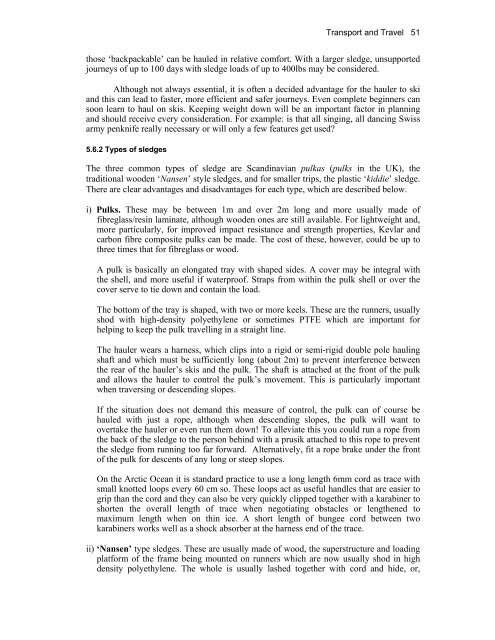Edited by Rachel Duncan 4th Edition ISBN 0-907649-91-2 London ...
Edited by Rachel Duncan 4th Edition ISBN 0-907649-91-2 London ...
Edited by Rachel Duncan 4th Edition ISBN 0-907649-91-2 London ...
You also want an ePaper? Increase the reach of your titles
YUMPU automatically turns print PDFs into web optimized ePapers that Google loves.
Transport and Travel 51<br />
those ‘backpackable’ can be hauled in relative comfort. With a larger sledge, unsupported<br />
journeys of up to 100 days with sledge loads of up to 400lbs may be considered.<br />
Although not always essential, it is often a decided advantage for the hauler to ski<br />
and this can lead to faster, more efficient and safer journeys. Even complete beginners can<br />
soon learn to haul on skis. Keeping weight down will be an important factor in planning<br />
and should receive every consideration. For example: is that all singing, all dancing Swiss<br />
army penknife really necessary or will only a few features get used?<br />
5.6.2 Types of sledges<br />
The three common types of sledge are Scandinavian pulkas (pulks in the UK), the<br />
traditional wooden ‘Nansen’ style sledges, and for smaller trips, the plastic ‘kiddie’ sledge.<br />
There are clear advantages and disadvantages for each type, which are described below.<br />
i) Pulks. These may be between 1m and over 2m long and more usually made of<br />
fibreglass/resin laminate, although wooden ones are still available. For lightweight and,<br />
more particularly, for improved impact resistance and strength properties, Kevlar and<br />
carbon fibre composite pulks can be made. The cost of these, however, could be up to<br />
three times that for fibreglass or wood.<br />
A pulk is basically an elongated tray with shaped sides. A cover may be integral with<br />
the shell, and more useful if waterproof. Straps from within the pulk shell or over the<br />
cover serve to tie down and contain the load.<br />
The bottom of the tray is shaped, with two or more keels. These are the runners, usually<br />
shod with high-density polyethylene or sometimes PTFE which are important for<br />
helping to keep the pulk travelling in a straight line.<br />
The hauler wears a harness, which clips into a rigid or semi-rigid double pole hauling<br />
shaft and which must be sufficiently long (about 2m) to prevent interference between<br />
the rear of the hauler’s skis and the pulk. The shaft is attached at the front of the pulk<br />
and allows the hauler to control the pulk’s movement. This is particularly important<br />
when traversing or descending slopes.<br />
If the situation does not demand this measure of control, the pulk can of course be<br />
hauled with just a rope, although when descending slopes, the pulk will want to<br />
overtake the hauler or even run them down! To alleviate this you could run a rope from<br />
the back of the sledge to the person behind with a prusik attached to this rope to prevent<br />
the sledge from running too far forward. Alternatively, fit a rope brake under the front<br />
of the pulk for descents of any long or steep slopes.<br />
On the Arctic Ocean it is standard practice to use a long length 6mm cord as trace with<br />
small knotted loops every 60 cm so. These loops act as useful handles that are easier to<br />
grip than the cord and they can also be very quickly clipped together with a karabiner to<br />
shorten the overall length of trace when negotiating obstacles or lengthened to<br />
maximum length when on thin ice. A short length of bungee cord between two<br />
karabiners works well as a shock absorber at the harness end of the trace.<br />
ii) ‘Nansen’ type sledges. These are usually made of wood, the superstructure and loading<br />
platform of the frame being mounted on runners which are now usually shod in high<br />
density polyethylene. The whole is usually lashed together with cord and hide, or,

















